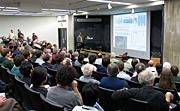- Number 310 |
- April 26, 2010
MINOS neutrino experiment continues race

MINOS collaborator Ryan
Patterson delivers a talk
about the experiment's
latest result at Fermilab.
Scientists working on the MINOS neutrino experiment at DOE’s Fermi National Accelerator Laboratory have set tighter constraints on the last neutrino mixing angle that still eludes experimental detection. Measuring this angle, known as theta-one-three, could help answer questions regarding the abundance of matter over antimatter in our universe.
Scientists know that there are three types, or flavors, of neutrinos (electron, muon and tau). In the last decade, they’ve discovered that neutrinos can change flavors and hence switch identities. Since neutrinos travel close to the speed of light, they often have to travel long distances before the change in flavors becomes noticeable. The MINOS experiment examines the properties of a neutrino beam that travels 735 kilometers from Fermilab to an underground laboratory in northern Minnesota. Leaving Fermilab, the beam almost entirely consists of muon neutrinos. Scientists expect that many of the muon neutrinos turn into tau neutrinos and a small fraction could change into electron neutrinos by the time they arrive in Minnesota. The MINOS detector in Soudan, Minn., observes indeed a significant drop in the number of neutrinos that arrive with muon flavor and attempts to measure the small fraction of electron neutrinos.
The transformation of a muon neutrino into an electron neutrino requires a non-zero value of the mixing angle θ13. If θ13 is zero, MINOS scientists expect to identify 49.1 ± 7.0(stat.) ± 2.7(syst.) events in the far detector. If θ13 is small but not zero, then the far detector would see more electron neutrino events. On April 9, MINOS scientists announced that they had found 54 events, a result consistent both with θ13=0 and θ13 being small but not quite zero. The result further narrows the range of allowed values of the unknown mixing angle. The race to measure the exact value of θ13 continues.
[Kurt Riesselmann, 630/840-5681,
kurtr@fnal.gov]
